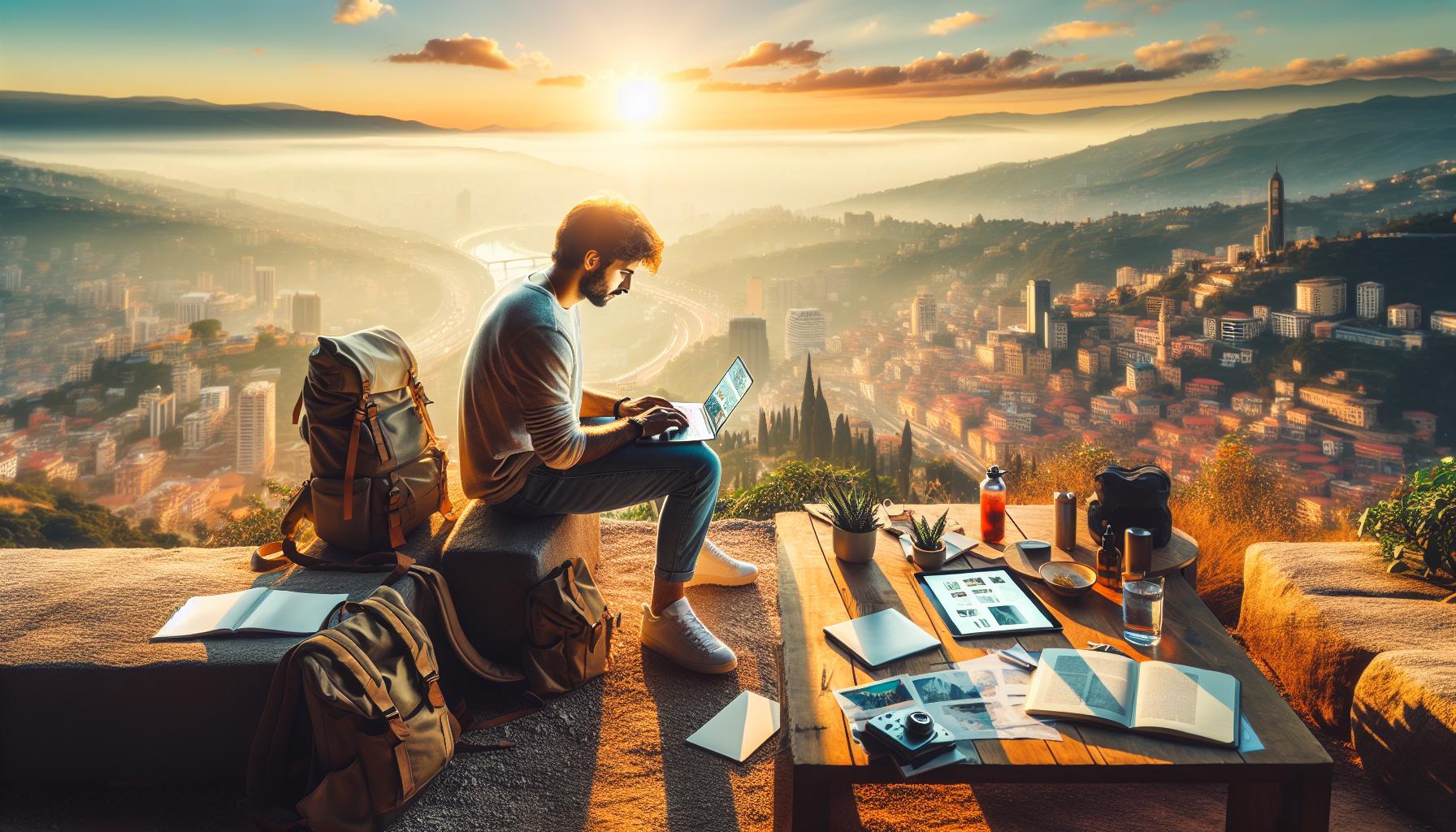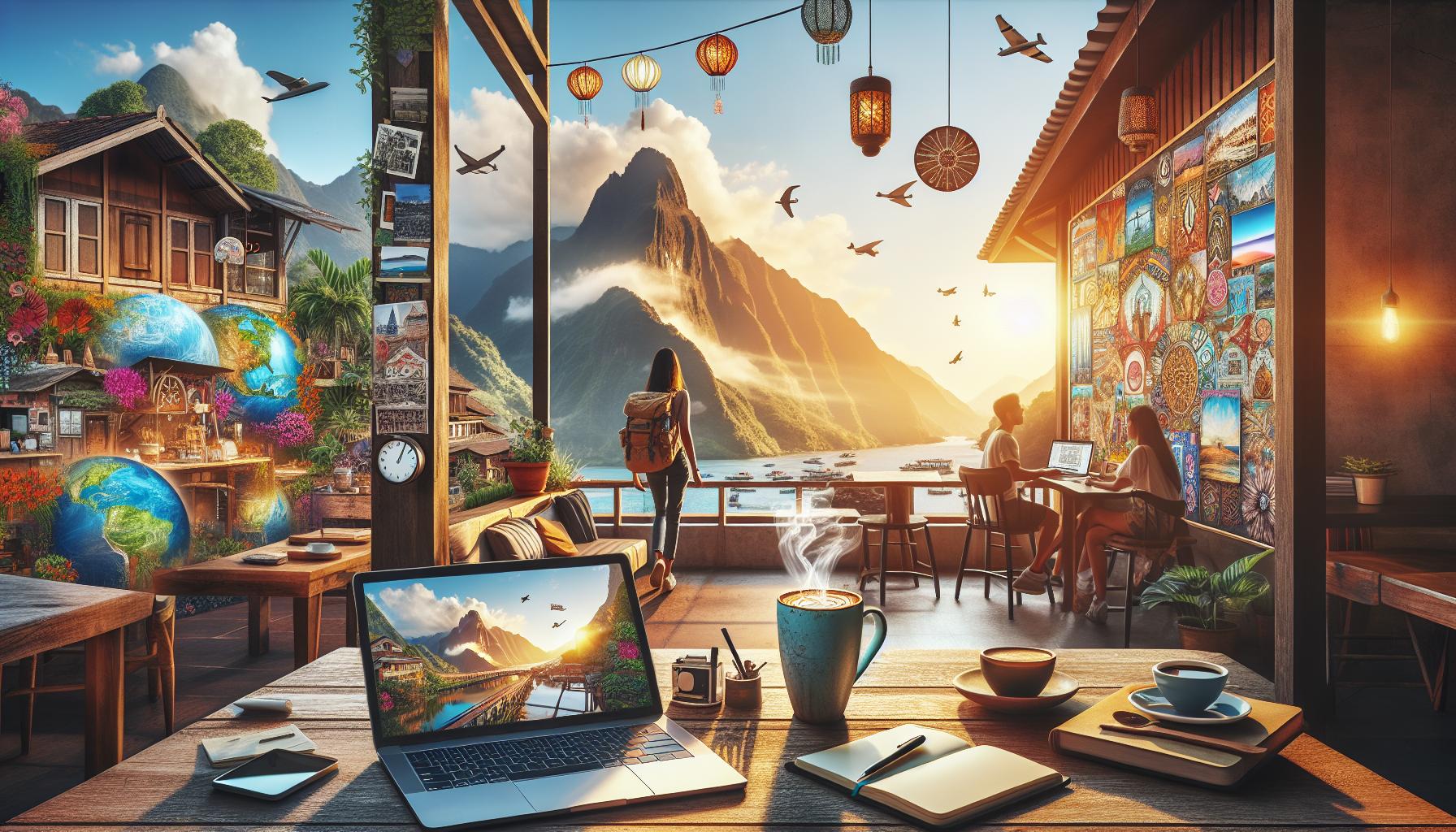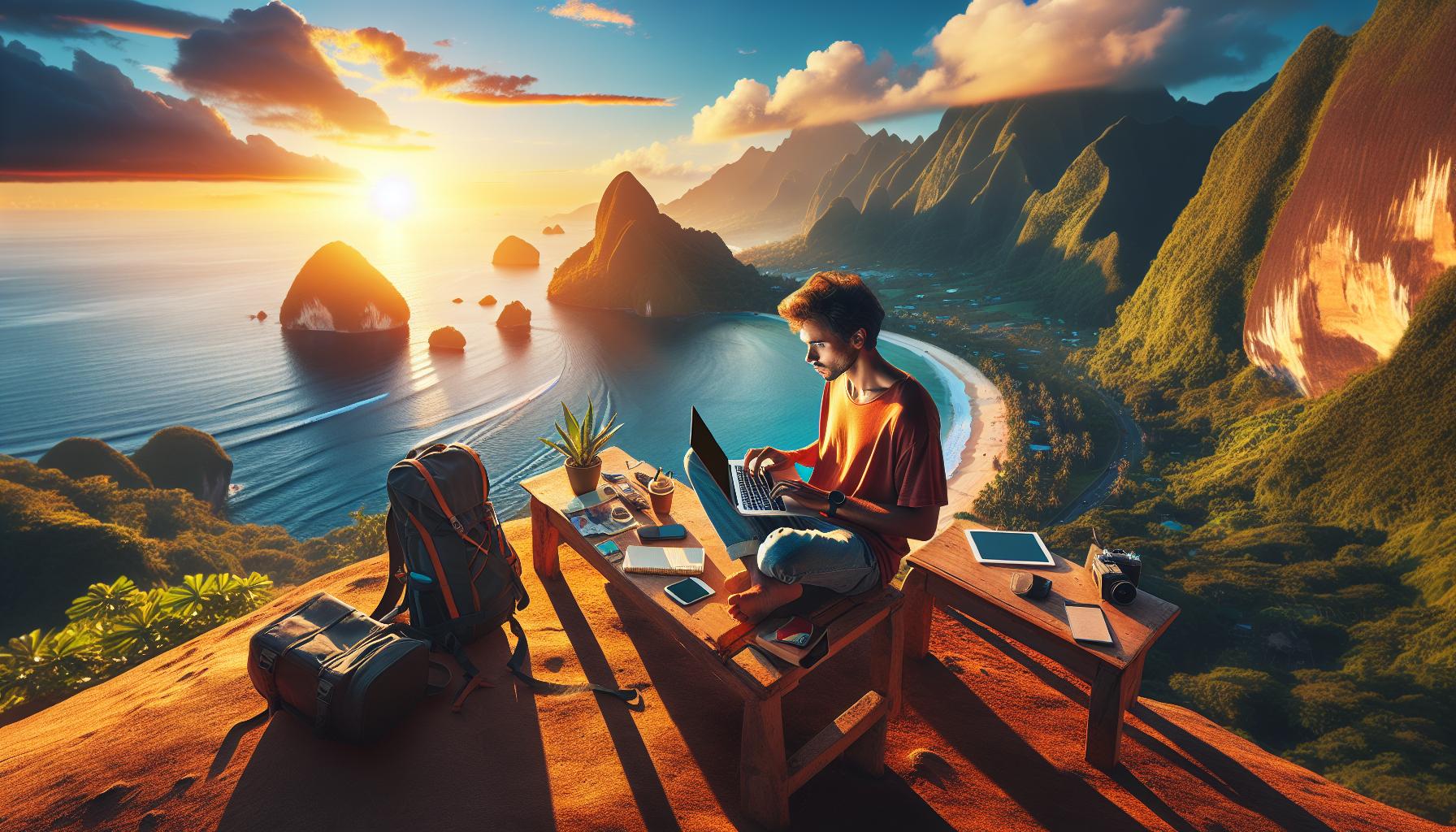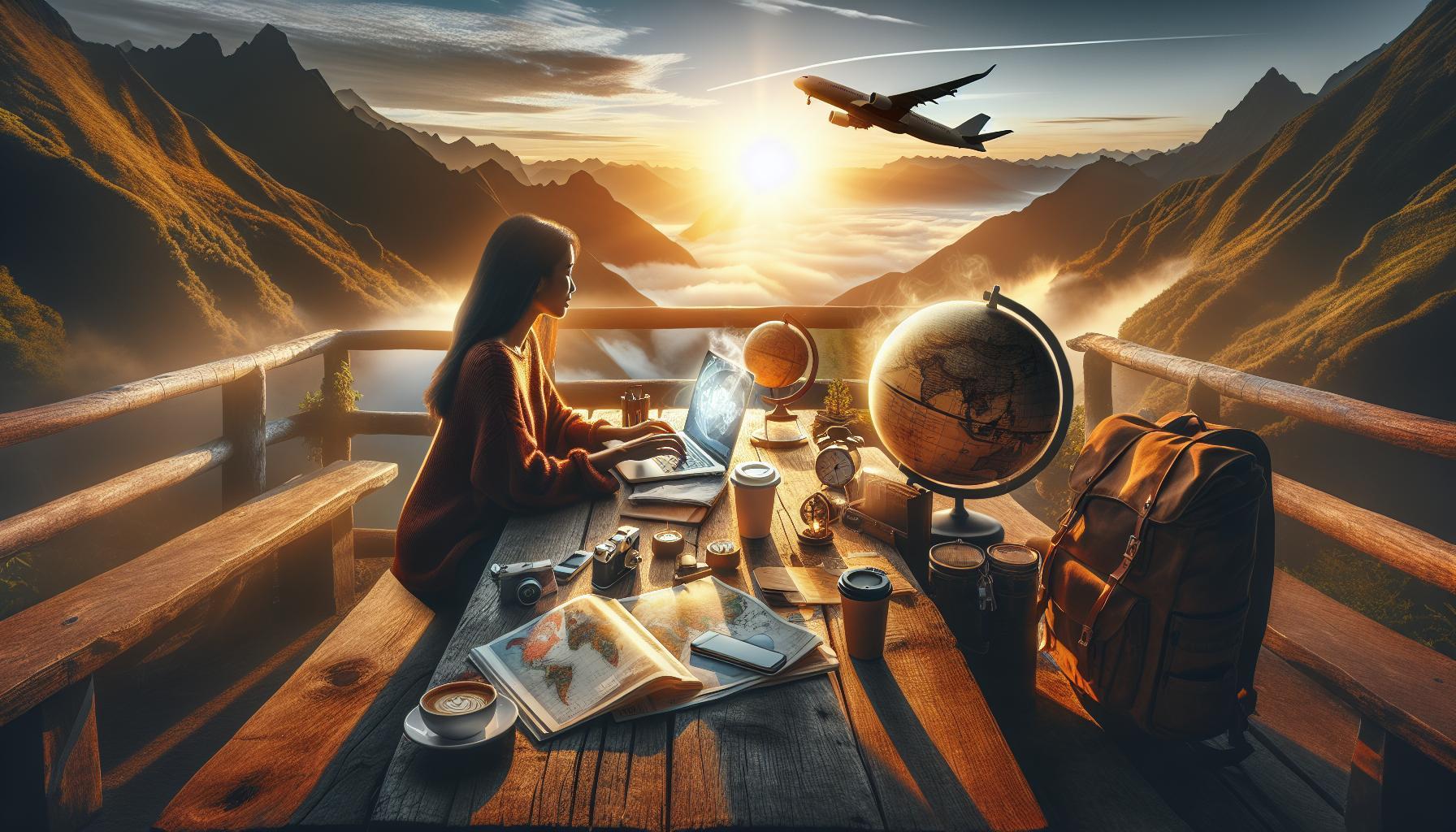Embarking on a solo travel adventure can be one of the most empowering experiences in life, allowing you to discover new places and learn more about yourself along the way. In this step-by-step guide for first-timers, we’ll walk you through the essentials of planning your journey-from picking a destination to navigating the logistics of travel safety.
Have you ever dreamed of wandering through bustling markets or hiking breathtaking landscapes, all on your own terms? Many hesitate, unsure where to start or how to tackle potential challenges. This guide aims to alleviate those concerns, offering practical tips that will boost your confidence and ensure your trip is enjoyable and fulfilling.
Whether you’re seeking adventure, relaxation, or personal growth, understanding how to effectively plan your solo travel will help you create unforgettable memories. Join us as we dive into the vital steps that will set you up for a successful journey, opening the door to a world of exploration and self-discovery.
Choosing Your Ideal Solo Travel Destination
Choosing the right destination for your solo adventure can be one of the most exhilarating parts of the planning process. The world is filled with a multitude of options, and sometimes it can be overwhelming to narrow down where to go, especially if it’s your first solo trip. Start by reflecting on your interests-are you drawn to vibrant cities rich in culture, serene beaches for relaxation, or hiking trails that promise adventure? Each type of destination offers a unique experience that can cater to solitary exploration.
Another critical aspect to consider is safety and comfort levels in different locations. Countries or cities known for being solo traveler-friendly, such as Japan, Portugal, or New Zealand, often have a reputation for safety and hospitality towards visitors. Research online forums or travel blogs to gather insights from those who have traveled solo in these destinations. Websites like Nomadic Sage provide a wealth of tips focusing on safety and cultural insights, which are vital for ensuring a smoother journey [[3]].
It’s also wise to think about the local culture and communication. A destination where you can easily navigate language barriers or find English speakers can significantly enhance your experience. Choose places with accessible transportation, welcoming locals, and rich opportunities for cultural exchange. Engaging with local communities can elevate your trip and also provide you with chances to meet fellow travelers, ensuring you don’t feel lonely on your journey.
Finally, reflect on logistical considerations such as budget, climate, and travel duration. Create a short list of potential destinations and evaluate them based on your budget, local prices for food and accommodations, and your own comfort with the climate during your time of travel. Many first-timers find it helpful to start close to home before venturing further away-it can be an empowering step towards discovering what you’re capable of on your own. By taking the time to choose well, your solo adventure can promise not just exploration, but also self-discovery and lasting memories.
Researching Safety and Cultural Considerations
When embarking on a solo travel adventure, understanding the safety and cultural landscape of your chosen destination lays the groundwork for a rewarding experience. Imagine exploring streets that beckon with rich history and vibrant connections, while simultaneously feeling secure and welcomed. To ensure this balance, start your research by looking for places renowned for their hospitality towards solo travelers. Countries like Japan, known for its traditional customs and low crime rates, or Portugal, celebrated for its friendly locals, can serve as excellent first steps on your journey.
Delve into travel blogs, forums, and social media groups dedicated to solo travel to gather firsthand accounts and nuanced insights about your destination. Pay attention to topics such as local customs, dress codes, and etiquette. Understanding these cultural nuances not only helps you blend in but also demonstrates respect for the local community, enriching your experience. It’s also wise to familiarize yourself with the general safety protocols unique to the area, including emergency contacts and locations of safe spaces. Websites such as Nomadic Sage provide excellent resources, offering insights on both safety and cultural considerations that are vital for your journey.
Language barriers can pose challenges, but choosing destinations where English is commonly spoken or where you can easily communicate through translation apps can enhance your experience significantly. Enlist the help of local tours or group activities, as these not only provide structure to your itinerary but also offer opportunities to connect with fellow travelers and locals, enriching both your social network and cultural understanding.
Lastly, don’t forget to consider logistical aspects related to safety, such as local transportation and neighborhood safety ratings. Research public transport options and their reliability, especially when traveling at night, and learn to identify neighborhoods that are known to be safe and those best avoided. This proactive approach will not only give you peace of mind but will also empower you to fully immerse yourself in the adventure of traveling solo. Through diligent research and a respectful mindset, your solo journey can blossom into an inspiring odyssey of cultural discovery and personal growth.
Budgeting for Your Solo Adventure
Setting off on a solo adventure is both exhilarating and daunting, and understanding how to budget effectively can make all the difference in turning your dream journey into reality. A well-thought-out budget not only ensures that you cover all essential expenses but also allows for some spontaneous experiences that enrich your travels. The key is to approach budgeting with a balance of realism and a bit of adventurous spirit.
Start by determining your overall travel costs. Consider both fixed expenses such as flights and accommodations, alongside variable costs like food, activities, and local transport. Creating a detailed breakdown helps clarify how much you need to save before your departure. Use tools like spreadsheets or budgeting apps to keep track of your estimated expenses versus your actual spending. This not only helps you stay on target but provides insight into where you can cut costs or splash out a bit more.
Practical Tips for Budgeting
- Prioritize Your Spending: Decide what aspects of your trip are most important to you. Whether it’s dining at renowned restaurants, engaging in unique activities, or staying in prime locations, understanding your priorities will guide your budget.
- Research Destinations: Different locations have varying costs of living. For instance, Southeast Asia is often more affordable than Western Europe. Consider less popular destinations that still offer rich cultural experiences but at a lower price point.
- Utilize Local Transportation: Instead of relying on taxis or rideshares, familiarize yourself with public transport options. Not only is it cheaper, but it also immerses you in local life.
- Seek Out Free Activities: Many cities offer free walking tours, museum nights, or local festivals. These experiences allow you to explore without breaking the bank.
- Consider Accommodation Alternatives: Hostels, guesthouses, or home-sharing platforms like Airbnb can significantly reduce lodging costs while enhancing your local experience.
Remember to incorporate a buffer into your budget for unexpected expenses. Emergencies can arise at any moment, whether that’s needing a last-minute hotel due to flight delays or an enticing local tour you didn’t plan for. Building in this flexibility will give you peace of mind and allow for greater exploration.
Ultimately, is about aligning your financial plan with your travel aspirations, ensuring that every dollar spent contributes to an enriching experience. With a clear budget in hand and a willingness to explore, you are well-equipped to embark on a journey filled with discovery and unforgettable memories.
Booking Accommodations: Tips for Travelers
Finding the perfect place to stay during your solo travel adventure can significantly enhance your experience. It sets the tone for your journey and impacts how you’ll interact with your destination. Whether you prefer the vibrant atmosphere of a hostel, the comfort of a boutique hotel, or the unique flair of a guesthouse, understanding your options can help you find accommodations that align with your needs and budget.
When booking accommodations, consider what environment will make you feel most comfortable. For example, if you’re looking to meet fellow travelers, hostels often provide not just affordable lodging but also communal areas that encourage socializing. Look for hostels that offer organized activities, as these are perfect for initiating conversations. On the other hand, if you prefer privacy and a more relaxed atmosphere, boutique hotels or guesthouses can provide a cozy retreat where you can recharge after exploring.
Tips for Booking Accommodations
- Read Reviews: Utilize platforms like TripAdvisor or Booking.com to check recent reviews. Look for solo traveler insights-they often highlight safety and community feelings.
- Location Matters: Research the neighborhoods where you’ll be staying. Being near public transport, restaurants, and key attractions can enhance your experience. Consider local safety, noise levels, and what amenities are nearby.
- Book Ahead: Especially during peak seasons, booking in advance increases your chances of securing accommodations that meet your preferences and budget.
- Look for Deals: Use price comparison sites to find promotions or discounts, especially for longer stays. Some hotels and hostels offer special rates for solo travelers.
- Consider Flexibility: If you’re uncertain about your itinerary, opt for accommodations with flexible cancellation policies. This allows you to change your plans without incurring heavy fees.
As you navigate through your options, don’t shy away from reaching out directly to property owners or managers. Sometimes, they can provide special deals or offer insights into local experiences you wouldn’t find online. Ultimately, choose a place that resonates with you and feels right; this personal touch will make your solo adventure all the more rewarding.
Navigating Transportation: Local Transport Options
Getting around a new city can be one of the most exhilarating parts of solo travel, opening the door to unexpected adventures and local experiences. Whether you’re meandering through cobbled streets or hopping on a train, understanding your transportation options is key to maximizing your exploration. Research local transport systems before you arrive, as this can save time, money, and a lot of confusion further down the road.
For many destinations, public transportation is not only the most cost-effective way to get around, but it also offers the opportunity to engage with locals. Options like buses, trams, and subways are common, so familiarize yourself with the routes and schedules. A smart move is to download local transport apps which can provide real-time information and help you navigate your way through the area more easily. If you prefer a more personal experience, consider car-sharing or bike-rental services, which can give you a sense of freedom and control over your travel pace.
Types of Local Transport Options
- Public Transit: Buses and trains are often the backbone of city transportation. Research routes ahead of time and purchase any necessary tickets in advance to avoid longer queues.
- Taxis and Rideshares: Apps like Uber and Lyft are convenient in many cities, offering door-to-door service. Traditional taxis can also be a reliable option, especially in areas where ridesharing services are limited.
- Bicycles: Many cities have bike-sharing programs that allow you to explore on two wheels. This is a great way to see more of a city at your own pace while enjoying the outdoors.
- Walking: Don’t underestimate the power of your own two feet! Walking can reveal hidden gems that you might miss while using public transport.
Remember to trust your instincts about safety; if a transportation option feels off, don’t hesitate to explore alternatives. Before using a service, check reviews and recommendations from fellow travelers. By embracing these local transport options, you not only enhance your travel experience but also open doors to authentic interactions-transforming your solo journey into an empowering adventure.
Staying Connected: Communication Tips Abroad
Staying connected while traveling solo enhances your experience and provides peace of mind. One of the most empowering aspects of traveling alone is knowing you can easily reach out for help or share your journey with friends and family back home. To ensure seamless communication during your travels, it’s essential to understand your options and plan ahead.
Start by selecting the right mobile plan. Many carriers offer international packages that allow you to use your phone abroad without incurring exorbitant fees. Alternatively, consider using local SIM cards once you arrive at your destination. This often provides better rates for data and calls, keeping you connected without the worry of roaming charges. Apps like WhatsApp, Zoom, or Skype are also invaluable for making calls or video chats without relying on phone networks. Just ensure that the local Wi-Fi is secure, and avoid accessing sensitive information over public networks.
Equipping yourself with a portable charger is another practical tip. Having your devices charged ensures you’re always ready to use navigation apps, communicate with new friends, or share that stunning sunset picture instantly. Additionally, download essential apps ahead of time, like translation tools that can assist in case language barriers arise. Knowing you can navigate unfamiliar places or communicate even in varied dialects can add a significant layer of confidence to your solo adventure.
As a bonus, consider documenting your experiences through social media or a travel blog. Beyond keeping your loved ones updated, this practice can create a community of fellow travelers who might offer advice or guide you on your journey. An active online presence can lead to meaningful connections and friendships, transforming your trip into an even richer experience. Remember, while you’re exploring new horizons alone, you’re never truly isolated in the digital age.
Solo Travel Safety: Staying Secure on the Road
When embarking on a solo travel adventure, your safety should always remain a top priority. The freedom of exploring new places alone can be exhilarating, but it also comes with responsibilities. Being proactive about your safety can enhance your trip and allow you to enjoy your experience without worry.
Start by researching your destination thoroughly. Knowing the local culture, customs, and travel advisories can help you navigate potential challenges. For instance, in countries where certain behaviors might be frowned upon, being aware of these norms can help you avoid unwanted attention or difficult situations. Connect with fellow travelers through forums and social media platforms to gather insights and tips about the safety landscape of your chosen destination.
Forming habits that keep you secure is vital. Always remain aware of your surroundings, especially in crowded areas. Trust your instincts-if something feels off, do not hesitate to leave the situation. It’s wise to dress like a local to reduce the risk of standing out as a tourist. Also, avoid displaying valuables such as expensive jewelry or large amounts of cash, which can attract unwanted attention.
To enhance your security on the road, consider using technology to your advantage. Apps that share your location with trusted contacts can ensure someone knows where you are at all times. Additionally, carrying a portable document protector or a cloud service to store scanned copies of your passport, travel insurance, and emergency contacts can create a backup in case of theft or loss. Establishing a simple daily routine can also provide a sense of stability, whether it’s familiarizing yourself with public transport routes or setting a designated check-in time with friends or family.
By incorporating these practical safety tips into your solo travel plans, you arm yourself with the knowledge and confidence to explore the world with a sense of security. Remember, your safety is in your hands, and with the right preparation, you can make the most of your adventure while ensuring a worry-free journey.
Meeting People While Traveling Alone
Embracing solo travel opens up a unique opportunity to forge connections that you might not encounter when traveling with others. The thrill of meeting new people adds depth to your journeys and can enrich your travel experience immeasurably. Solo adventurers often find that they are more approachable, as they navigate the world independently, creating an inviting aura that sparks conversations with both locals and fellow travelers alike.
One of the most effective ways to meet people while traveling is by staying in hostels or co-living spaces. These accommodations are designed to bring like-minded individuals together, providing communal areas where you can share stories, tips, and perhaps plan outings together. Joining organized activities or events offered by these places, such as guided city tours, cooking classes, or social nights, can break the ice and lead to friendships that last beyond your trip. In addition, consider platforms like Meetup or Couchsurfing, where you can discover local events based on your interests.
Engage with Locals
Interacting with locals is another rewarding way to connect while you explore. Learning a few basic phrases in the local language can go a long way in opening doors and establishing rapport. Whether you’re asking for directions or inquiring about the best local cuisine, these small gestures of effort can result in memorable exchanges. Volunteering during your travels can also provide an avenue to meet people who share your passion for service while deeply immersing yourself in the local community.
Social Media and Online Communities
In today’s digital age, leveraging social media can significantly enhance your social experiences while traveling alone. Engage with travel communities on platforms like Instagram, Facebook, or Reddit where you can ask for advice, meet up with fellow travelers, or join group tours. Many cities also have expat groups, offering a chance to meet locals and fellow travelers eager to share their experiences.
Moreover, don’t underestimate the power of a simple smile or approach. If you find yourself in a café, park, or any communal space, starting a conversation can lead to unexpected connections. Share a meal or visiting a local market can be excellent contexts for sparking conversations. Those interactions may lead you to hidden gems of the city or create companions to share adventures with.
isn’t just about filling the social void; it’s about creating lasting memories and stories to take back home. The friendships you forge and the stories you share can become the highlights of your journey, transforming the solitary traveler into a vital part of a global community.
Documenting Your Journey: Travel Journals and Blogs
Capturing your solo travel experiences through journaling or blogging can be one of the most rewarding aspects of your journey. Not only does it allow you to reflect on your adventures, but it also creates a tangible keepsake of memories that can last a lifetime. Whether you’re jotting down notes in a well-loved notebook or sharing your stories through an online blog, documenting your journey helps you process your experiences and articulate what makes each destination unique.
Choosing the Right Medium
Decide whether you prefer a traditional travel journal or a digital platform. A physical journal can be a personal, tactile way to write down your thoughts, while a blog or social media can connect you with a wider audience. Consider the following options:
- Travel Journal: Perfect for reflection and creativity, include sketches, tickets, and mementos alongside your writings.
- Blogging: Share your insights, tips, and experiences with others online. Platforms like WordPress or Medium can help you easily reach a broader audience.
- Social Media: Use Instagram or Facebook to document your travels with photos and short narratives, allowing friends and family to follow along in real-time.
Tips for Effective Documentation
To make the most of this enriching practice, consider these practical tips:
- Write Regularly: Set aside time each day to jot down your thoughts. Regular writing helps create a habit and ensures you capture details while they’re fresh.
- Be Authentic: Don’t worry about making your writing perfect. Share your true experiences, including the challenges, triumphs, and lessons learned.
- Incorporate Multimedia: Enhance your blog or journal with photos, videos, and audio clips. These elements can vividly bring your narratives to life.
Moreover, reflecting on your daily experiences can deepen your understanding of the world around you. Use prompts to guide your writing, such as “What surprised me today?” or “What did I learn from interacting with the locals?” This process transforms documentation into an enriching part of your travels.
Creating a personal archive not only preserves your memories but can also inspire fellow solo travelers. Your shared narratives, insights, and challenges will resonate with others, potentially motivating them to embark on their own journeys. So, whether you’re capturing awe-inspiring landscapes or recounting personal growth stories, remember that every entry is a step toward building a rich tapestry of your travel life.
Faq
Q: What are the best tips for first-time solo travelers?
A: First-time solo travelers should research their destination thoroughly, stay flexible with their itinerary, and prioritize safety by using reliable transport and accommodations. Engaging with locals and fellow travelers can enhance the experience and help build confidence on the road. Explore the section on “Meeting People While Traveling Alone” for more tips.
Q: How can I ensure my safety while traveling alone?
A: Ensuring safety while traveling alone involves staying aware of your surroundings, keeping emergency contacts handy, and avoiding risky areas. Share your travel itinerary with a trusted friend or family member. Check out the “Solo Travel Safety: Staying Secure on the Road” section for practical safety advice.
Q: What should I focus on when planning my solo travel itinerary?
A: Focus on balancing packed activities with downtime when planning your itinerary. Include must-see attractions and experiences, but allow for spontaneous adventures. This flexibility can lead to unexpected discoveries, enhancing your overall travel experience.
Q: How can I meet other travelers while on a solo trip?
A: Meeting other travelers can be done by joining group tours, attending local events, or staying in social accommodations like hostels. Apps designed for travelers can also facilitate connections. Visit the “Meeting People While Traveling Alone” section for additional strategies.
Q: What are essential items to pack for solo travel?
A: Essential items for solo travel include a reliable travel bag, safety gear like a money belt, essential toiletries, a power bank, and personal documentation. Refer to the “Packing Essentials for Solo Travelers” section for a comprehensive packing list and tips.
Q: When is the best time to start planning a solo trip?
A: The best time to start planning a solo trip is at least a few months in advance. This allows ample time for researching your destination, budgeting, and booking accommodations. Early planning helps alleviate stress and ensures better deals.
Q: What are some budgeting tips for solo travelers?
A: Budgeting for solo travel involves creating a daily spending plan, seeking affordable accommodations, and using public transportation. Consider dining at local markets or cooking your own meals to save money. Check out the “Budgeting for Your Solo Adventure” section for more insights.
Q: How can I stay connected while traveling solo?
A: Staying connected while traveling solo can be achieved by purchasing a local SIM card or using an international data plan. Utilize free Wi-Fi in cafes or public spaces for updates. For more communication tips, visit the “Staying Connected: Communication Tips Abroad” section.
Final Thoughts
Embarking on your solo travel adventure is a thrilling experience that can enhance your sense of independence and adventure. Remember, preparation is key: use the step-by-step guide you’ve just explored to help navigate your journey smoothly. If you have lingering questions about travel safety or packing tips, check out our resources on solo travel safety and travel gear essentials for additional insights. Don’t let hesitation hold you back-your dream destination awaits!
To stay updated with our latest tips and exclusive content, consider signing up for our newsletter. Share your thoughts and experiences in the comments section, and don’t forget to explore related articles on travel planning and destination guides. The world is vast, and your solo journey is just beginning. Embrace it with open arms and make unforgettable memories!





